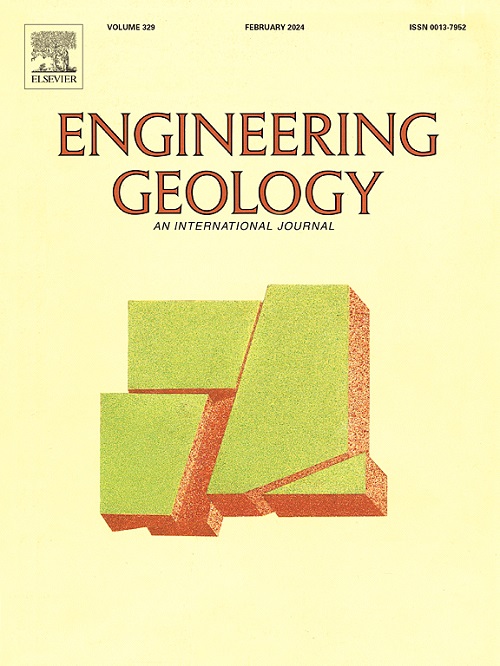Scale-dependent recursive analysis of topographical roughness: A methodology for differentiating geological and geomechanical features from point cloud data
IF 8.4
1区 工程技术
Q1 ENGINEERING, GEOLOGICAL
引用次数: 0
Abstract
Exposed rock surfaces reflect diverse topographical features shaped by underlying geological and geomechanical conditions, such as mineral composition, weathering, excavation methods, and structural geology. These features directly influence the mechanical behavior of in-place materials, providing a robust basis for differentiating geological and geomechanical units in engineering. Their explicit spatial differentiation relies on time-consuming and subjective visual assessments, or the inefficient and difficult to reproduce measurement of topographical features (e.g., roughness, undulation) at arbitrary scales. This work aims to offer an objective, reproducible, and efficient topographical analysis framework to differentiate geological and geomechanical features arising from natural and man-made origins. This study introduces a scale-dependent recursive analysis method to systematically evaluate and characterize roughness conditions of exposed rock surfaces. By analyzing point clouds across multiple scales, the method derives scale-dependent trends and computes parameters that distinguish topographical features associated with specific geological and operational settings. A moving-window algorithm is applied as a second layer of analysis to capture localized trends, integrating these as an explicit scalar field within point clouds for direct differentiation of features. This methodology improves accuracy and efficiency compared to traditional roughness measurement techniques by reducing biases and subjectivity associated with visual-based assessments. The approach is demonstrated using four datasets from diverse geological and geomechanical contexts, showcasing its applicability and the insights gained. The influence of point cloud density and moving-window size on the recursive analysis is further discussed, highlighting the method's potential to provide objective and quantifiable topographical differentiation for mining, tunneling, and construction applications.
地形粗糙度的尺度相关递归分析:从点云数据中区分地质和地质力学特征的方法
裸露的岩石表面反映了不同的地形特征,这些地形特征是由潜在的地质和地质力学条件形成的,比如矿物成分、风化、开挖方法和构造地质。这些特征直接影响就地材料的力学行为,为工程中区分地质和地质力学单元提供了坚实的基础。它们明确的空间分异依赖于耗时和主观的视觉评估,或者依赖于在任意尺度上对地形特征(如粗糙度、起伏)的低效和难以再现的测量。这项工作旨在提供一个客观的、可重复的、有效的地形分析框架,以区分自然和人为起源的地质和地质力学特征。本文介绍了一种依赖于尺度的递归分析方法来系统地评估和表征裸露岩石表面的粗糙度状况。通过分析多个尺度的点云,该方法推导出与尺度相关的趋势,并计算出与特定地质和操作环境相关的地形特征的参数。移动窗口算法作为第二层分析来捕获局部趋势,将这些作为点云内的显式标量场进行积分,以直接区分特征。与传统的粗糙度测量技术相比,该方法通过减少与基于视觉的评估相关的偏差和主观性,提高了准确性和效率。该方法使用了来自不同地质和地质力学背景的四个数据集,展示了其适用性和获得的见解。进一步讨论了点云密度和移动窗口大小对递归分析的影响,强调了该方法为采矿、隧道和建筑应用提供客观和可量化的地形区分的潜力。
本文章由计算机程序翻译,如有差异,请以英文原文为准。
求助全文
约1分钟内获得全文
求助全文
来源期刊

Engineering Geology
地学-地球科学综合
CiteScore
13.70
自引率
12.20%
发文量
327
审稿时长
5.6 months
期刊介绍:
Engineering Geology, an international interdisciplinary journal, serves as a bridge between earth sciences and engineering, focusing on geological and geotechnical engineering. It welcomes studies with relevance to engineering, environmental concerns, and safety, catering to engineering geologists with backgrounds in geology or civil/mining engineering. Topics include applied geomorphology, structural geology, geophysics, geochemistry, environmental geology, hydrogeology, land use planning, natural hazards, remote sensing, soil and rock mechanics, and applied geotechnical engineering. The journal provides a platform for research at the intersection of geology and engineering disciplines.
 求助内容:
求助内容: 应助结果提醒方式:
应助结果提醒方式:


